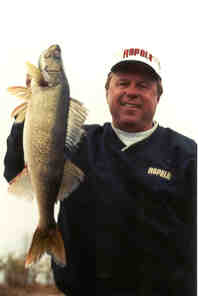The Complete Fishing Scene on Lake Erie
Subscriptions |
Fishing Reports &
Message Boards |
Charters | Lodging |
Walleye.com Shop
Guest Book What's New Contact Us Current Lake Conditions Boats For Sale
|
The Complete Fishing Scene on Lake Erie |
|
Guest Book What's New Contact Us Current Lake Conditions Boats For Sale |
Lake Erie Walleye Magazine
Summer 2002 Vol. 8, No. 2
Feature Article
|
HOT OFF THE PRESS
|
Hot Summer Walleyes by Norb Wallock
T he good ol’ summer time can be one of your best bets for catching numbers of big walleyes and it can also be one of the worst, depending on how you react to the season’s changing conditions. To be successful, anglers will have to give up on
what had been productive just a few short weeks ago and get with a program
more in tune with a walleye’s present needs. on
what had been productive just a few short weeks ago and get with a program
more in tune with a walleye’s present needs.
When a hot summer sun starts bearing down water temps can push into the lukewarm range, and early season patterns can quickly dry up. When it happens many anglers makethe mistake of believing that the walleyes are simply not feeding, but nothing could be further from the truth. In fact, walleyes will feed even more heavily at this time of the year, and it’s when they make their biggest growth gains. One of the reasons anglers can find the going during the summer months a little tough is because they haven’t made the necessary adjustments required to stay with a fish that’s on the move. Walleyes make a living by taking advantage of their opportunities, and in many cases those opportunities are no where near where they were at the beginning of the season. As spring slides into summer there is a shallow to deep migration that occurs on most bodies of water. The migration doesn’t happen overnight, and not all of the walleyes in a system make the move to deep structure. Instead, the process more likely begins with a few scattered groups of fish showing up on deeper haunts like sunken humps, underwater points, and even flats, followed by a slow and steady migration that eventually results in fishable numbers of walleyes. As more and more walleyes make the deeper move, concentrations of ish begin to build up creating a terrific opportunity for anglers in the know. Knowing it can happen is the easy part, while capitalizing on it takes a little more effort. To get the most out of a good summer pattern you have to be prepared to give up on what you think you know, and let the fish do the talking. One of the most appealing aspects of locating walleyes holding on deep structure is the fact that they show up readily on good electronics. A high quality graph like the Raymarine L750, can help quickly narrow down your search. The L750’s high level of definition and white line feature can help you locate walleyes that are holding belly bottom, which is a common occurrence. The key to the whole process is keeping your lines in the boat, and relying totally on your electronics to divulge the whereabouts of deep running walleyes. It takes a little self control, but you can save a ton of valuable time if you do the investigative work up front. The fact is you’ll never ever catch them where they’re not, and if you’re not marking, you’re not on ‘em. Another terrific time saving device is a Global Positioning System like the Raymarine 425, which utilizes the new W.A.S.S. system. The 425 provides an incredible level of accuracy (within three meters), which can literally get you back to an exact spot time after time. The 425 has a plot chart that shows where you’ve been, and where you are going, which can keep you from retracing unproductive paths. It can also get you back to areas that have showed some promise. As you cruise potential hangouts you can place icons on the screen where you have marked schools of fish, allowing you to return to the exact spot after your investigative work is done. Once you’ve marked enough fish in a particular area it’s time to get down to business and try to put a couple in the boat. Good summer presentations involve an element of speed, like trolling crankbaits or spinners. With an increase in water temperature a walleye’s metabolism increases accordingly. A quicker moving bait appeals to that bump in metabolism and will often get snapped up while a slower offering gets completely ignored. A top pick for working unfamiliar waters would have to be a spinner and live bait combination behind a heavy bottom bouncer. Bottom bouncers run relatively snag free which can be a big plus when working an uneven bottom with plenty of potential hang-ups. They also allow you to keep your bait running close to the bottom without actually dragging it, and helps to keep your offering at ‘eye level. There are exceptions to the deep summer patterns, and these include dark or stained bodies of water where visibility is extremely limited. There may still be a shallow to deep migration but it may occur on a much smaller scale. The thing is the fish are still there, and some of them can still be caught, and it might as well be by you.
|
|
|
|
|
WE DELIVER! |